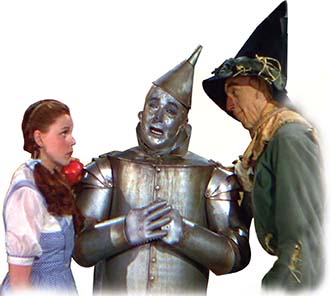SECTION 4: Culture of the 1930s

▲ The Wizard of Oz’s Dorothy, Tin Man, and Scarecrow
WITNESS HISTORY  AUDIO
AUDIO
“Somewhere Over the Rainbow”
Americans eager to escape the gloom of the depression regularly sought refuge in the fantasy world presented by the movies. One of their favorites was The Wizard of Oz, which opened in 1939. In an early scene, the farm girl Dorothy sings of better times:
“Somewhere over the rainbow
Way up high,
There’s a land that I’ve heard of
Once in a lullaby.
Somewhere over the rainbow
Skies are blue,
And the dreams that you dare to dream
Really do come true.
Some day I’ll wish upon a star
And wake up where the clouds are far behind me.
Where troubles melt like lemon drops
Away above the chimney tops
That’s where you’ll find me.”
—“Over the Rainbow,” E. Y. Harburg, 1939
Objectives
- Trace the growth of radio and the movies in the 1930s and the changes in popular culture.
- Describe the major themes of literature in the New Deal era.
Terms and People
- Frank Capra
- Federal Art Project
- mural
- Dorothea Lange
- John Steinbeck
- Lillian Hellman
NoteTaking
Reading Skill: Identify Main Ideas and Details Complete a table like the one below to record examples of cultural or popular media.
| Cultural or Popular Media | Example |
|---|---|
| Movies | |
Why It Matters Mass entertainment, such as The Wizard of Oz, flourished during the New Deal years as Americans sought escape from the worries of the depression. And, for the first time, the government played an active role in the arts, creating programs that put artists to work. It was a golden age for entertainment, and the movies, music, and works of literature produced during this era hold a unique place in American culture. Section Focus Question: How did the men and women of the depression find relief from their hardships in the popular culture?
Movies and Radio Captivate Americans
Entertainment became big business during the 1930s. Large radio networks, such as NBC and CBS, were broadcasting giants while a cluster of film companies—including MGM, Warner Brothers, Twentieth Century Fox, and Paramount—dominated the silver screen. By 1935, two in three homes owned a radio; by the end of the decade, about nine in ten did. In 1939, nearly two thirds of all Americans attended at least one movie a week. Stars in both industries made fortunes and attracted loyal followings. Glossy fan magazines tracked the stars’ personal and professional lives.




